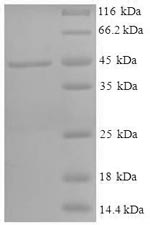The production of this Recombinant Human HSD11B1 protein started with the HSD11B1 gene synthesis. And then using recombinant DNA technology, the HSD11B1 gene was inserted into an expression vector so that we could get the recombinant express plasmid of HSD11B1. Transform the plasmid into the cells of E.coli, culture the cells and we could get the desired Recombinant Human HSD11B1 protein. But the work was not completed, protein purification and a strict QC system were performed in the last step. The purity is 90%+ determined by SDS-PAGE.
HSD11B1 is a gene providing an instruction of making a protein named Corticosteroid 11-beta-dehydrogenase isozyme 1 (HSD11B1) in human. The protein encoded by this gene is also known as 11-beta-hydroxysteroid dehydrogenase 1 (11-DH or 11-beta-HSD1) and short chain dehydrogenase/reductase family 26C member 1. The encoded protein is involved in lung development and steroid catabolic process with 11-beta-hydroxysteroid dehydrogenase (NADP+) and protein homodimerization activity. Moreover, it can bind to NADP and steroid.






